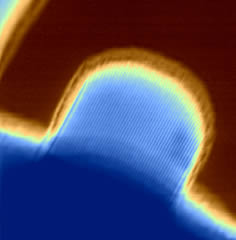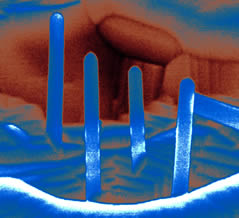Quite by chance, researchers in the Departments Laboratory for Nanoscale Science have discovered a process which has rendered fellow researchers in the field speechless.

They have discovered how to fabricate single crystals of carbon nanotubes in neatly ordered arrays, a discovery which should allow the full potential of this unique form of carbon to be realised.
"Our findings were totally unexpected - it was one of those amazing results that happens almost by chance. We were actually trying to fill nanotubes with metal, using a technique that had been reported elsewhere, when we realised that we had succeeded in producing arrays of perfect nanotubes, something that has not been achieved before," comments Dr Colm Durkan, a lecturer in the Department of Engineering.
"We discovered that by using fullerene molecules, a form of carbon commonly known as 'Bucky Balls', as the starting point for growing nanotubes, adding a suitable catalyst and heating to 900°C, we can produce arrays of aligned carbon nanotubes, all with identical properties. These are single crystals of carbon in a new form. That means we now have the technology to fabricate nanotubes with the electrical and mechanical properties that we require, and we can position them where we want and at any orientation. This is also a major step towards being able to produce carbon nanotubes as a bulk material, and we can already begin to investigate many different applications for the material."
Since its first discovery in 1991, the existence of a new form of carbon as nanotubes, has excited scientists the world over. Carbon in the form of nanotubes has the potential to form a material of great mechanical strength (hundred times stronger than steel) as well as displaying remarkable electrical properties. Depending on the arrangement of the atoms within the nanotubes, they can either be conducting, insulating or act as semiconductors: and as the tubes are so small, with diameters of the order of 1nm (ten thousand times less than a human hair) whilst still being extremely good conductors of electricity the implications for miniaturisation and speeding up of electronic components are immense.
The stumbling block to date has been how to fabricate the tubes in such a way as to produce the required properties. All the known methods of fabrication produced a disordered mass of tubes with correspondingly random structures and properties. That is all about to change, with a major breakthrough made in the Department's Nanoscale Science Laboratory (NSL) headed by Professor Mark Welland, in conjunction with Professor Jim Gimzewski at UCLA and Dr. Maria Seo at IBM, Zurich.

The work has been described by other workers in the field as the most stunning result in 'buckytube' research in a year. "It was so unexpected to fabricate perfect crystalline arrays of nanotubes in this way, when all previous attempts have shown nanotubes wrapped together looking like plates of spaghetti" says Professor Mark Welland. "We couldn't believe it at first, and it has taken six months before we were convinced that what we were seeing was real. I am still amazed at the beautiful images of these crystals."
The team will now continue their research into the electrical and mechanical properties of the various crystalline forms of the new material, and will look towards developing applications.
Copies of the article 'Single Crystals of Single-Walled Carbon Nanotubes Formed by Self-Assembly' (published on 5th April) are obtainable from Science Express.
This research has also recently been featured in the Financial Times
For further information, contact Professor Mark Welland, Department of Engineering, Trumpington Street, Cambridge, CB2 1PZ. Tel:01223 332676

